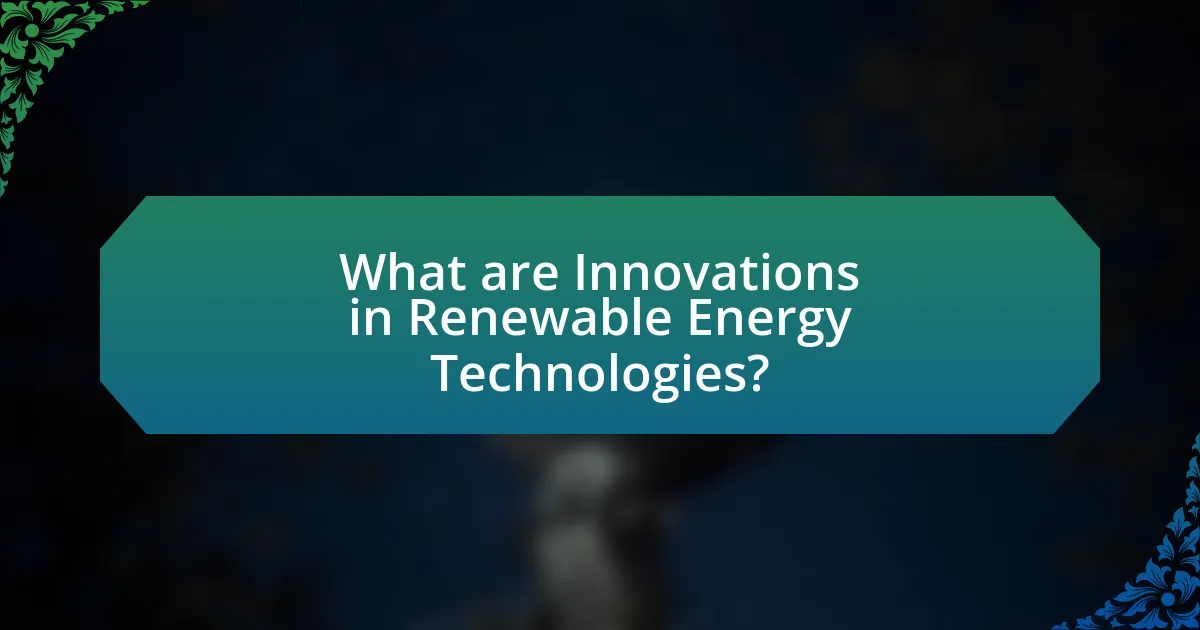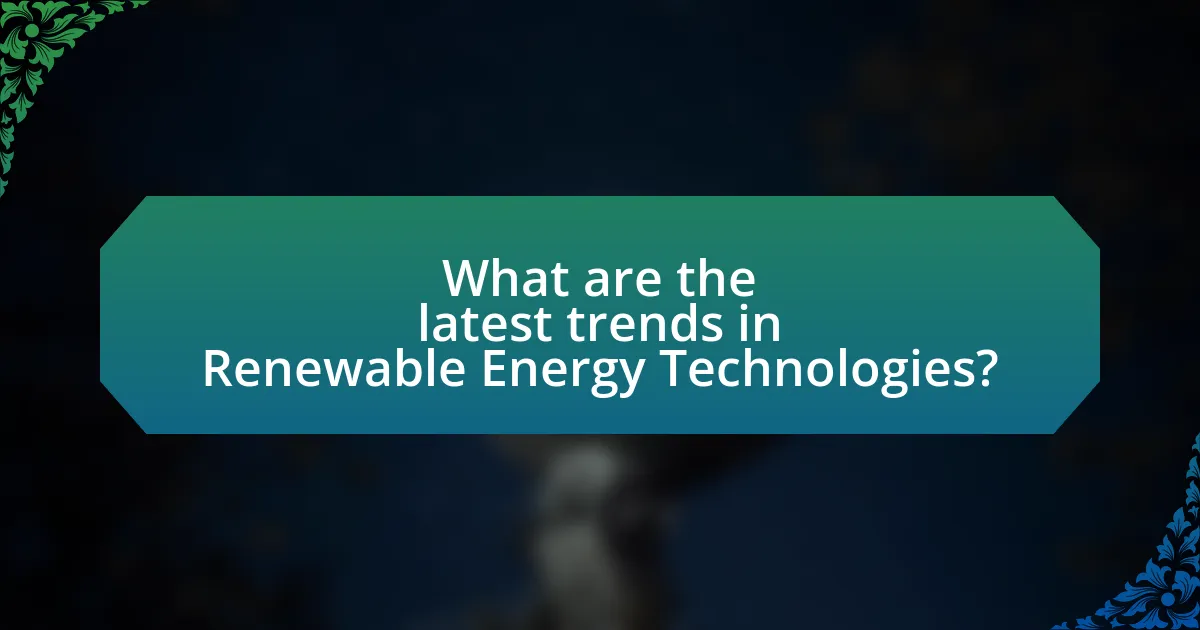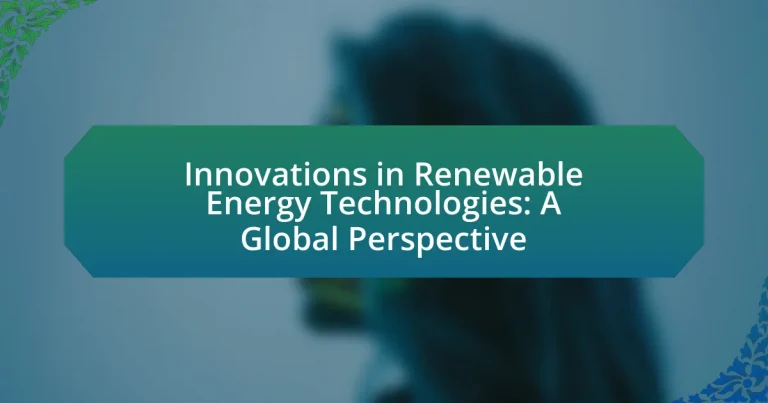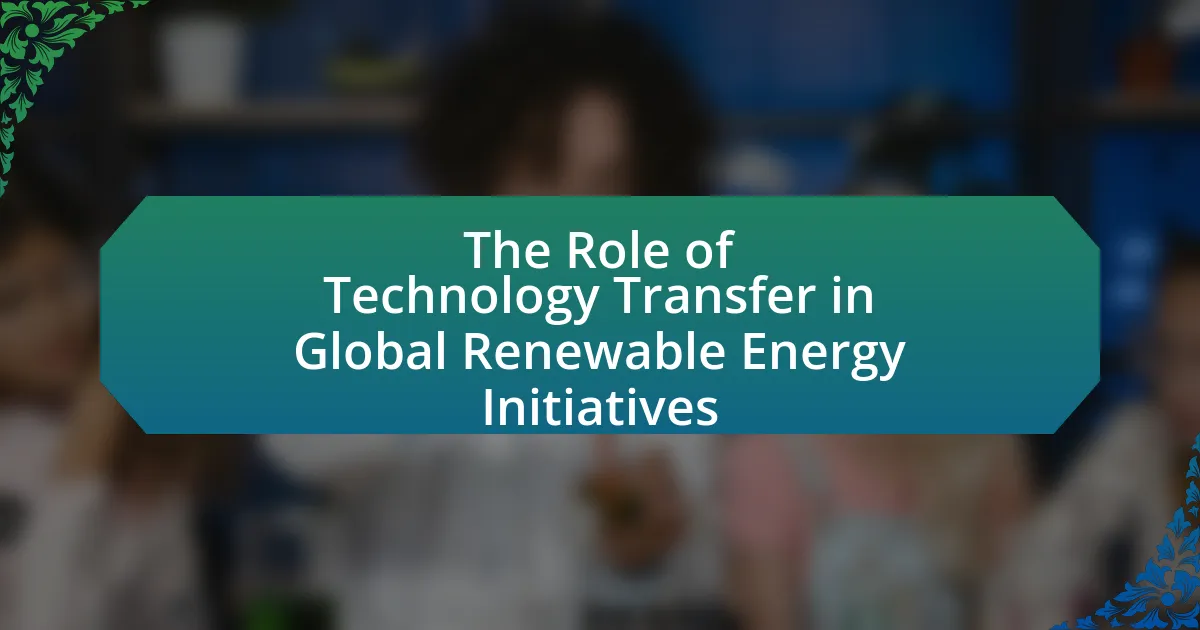Innovations in renewable energy technologies encompass advancements in solar photovoltaic systems, offshore wind turbine designs, and energy storage solutions, significantly enhancing efficiency and reducing reliance on fossil fuels. Key technologies driving these innovations include improved solar panels, larger wind turbines, and advanced battery systems, which collectively contribute to a more sustainable energy future. The article explores the global impact of these innovations on energy consumption, the roles of different countries in advancing technologies, and the challenges faced in the sector, including regulatory hurdles and environmental considerations. Additionally, it highlights best practices for implementing renewable energy solutions and strategies for businesses and governments to promote adoption.

What are Innovations in Renewable Energy Technologies?
Innovations in renewable energy technologies include advancements such as solar photovoltaic efficiency improvements, offshore wind turbine design enhancements, and energy storage solutions like lithium-ion and solid-state batteries. For instance, solar panels have seen efficiency rates increase from around 15% to over 22% in recent years due to new materials and manufacturing techniques. Additionally, offshore wind farms are now utilizing larger turbines that can generate more power, with some reaching capacities of over 12 megawatts. Energy storage technologies have also evolved, with solid-state batteries offering higher energy densities and faster charging times compared to traditional lithium-ion batteries. These innovations collectively contribute to the increased viability and adoption of renewable energy sources globally.
How do these innovations impact global energy consumption?
Innovations in renewable energy technologies significantly reduce global energy consumption by increasing efficiency and promoting sustainable practices. For instance, advancements in solar panel efficiency have led to a decrease in the amount of land and resources needed to generate electricity, allowing for more energy production with less input. According to the International Renewable Energy Agency (IRENA), the global capacity of solar energy has increased from 40 gigawatts in 2010 to over 800 gigawatts in 2020, demonstrating a substantial shift towards cleaner energy sources. Additionally, innovations in energy storage, such as lithium-ion batteries, enable better management of energy supply and demand, further optimizing energy use. These developments collectively contribute to a decrease in reliance on fossil fuels, thereby lowering overall global energy consumption and promoting a transition to a more sustainable energy future.
What are the key technologies driving these innovations?
The key technologies driving innovations in renewable energy include solar photovoltaic systems, wind turbine technology, energy storage solutions, and smart grid systems. Solar photovoltaic systems convert sunlight directly into electricity, with advancements in efficiency and cost reduction making them increasingly viable. Wind turbine technology has evolved to include larger, more efficient turbines that can generate more power from lower wind speeds. Energy storage solutions, particularly lithium-ion batteries, enable the storage of energy generated from renewable sources for use during periods of low generation. Smart grid systems enhance the management and distribution of electricity, integrating various renewable sources and improving overall energy efficiency. These technologies collectively contribute to the transition towards sustainable energy systems globally.
How do these technologies compare to traditional energy sources?
Renewable energy technologies, such as solar and wind, offer significant advantages over traditional energy sources like coal and natural gas. These advantages include lower greenhouse gas emissions, reduced air pollution, and decreased reliance on finite resources. For instance, according to the International Renewable Energy Agency (IRENA), solar and wind energy can reduce carbon emissions by up to 70% compared to fossil fuels. Additionally, renewable technologies often have lower operational costs over time, as they harness natural resources that are free, unlike fossil fuels which require extraction and transportation. This shift not only promotes environmental sustainability but also enhances energy security by diversifying energy supply sources.
Why is the global perspective important in renewable energy innovations?
The global perspective is important in renewable energy innovations because it fosters collaboration, knowledge sharing, and the adoption of best practices across different regions. This interconnected approach enables countries to leverage diverse technological advancements and policy frameworks, enhancing the effectiveness of renewable energy solutions. For instance, the International Renewable Energy Agency (IRENA) reported that global cooperation in renewable energy can lead to a 70% reduction in costs by 2030, demonstrating the tangible benefits of a unified global strategy.
What role do different countries play in advancing renewable energy technologies?
Different countries play crucial roles in advancing renewable energy technologies through policy support, investment, and innovation. For instance, Germany has been a leader in solar energy adoption, implementing the Feed-in Tariff policy that incentivizes renewable energy production, resulting in over 40% of its electricity coming from renewable sources by 2020. China, as the largest manufacturer of solar panels and wind turbines, has significantly reduced costs and increased global supply, contributing to a 70% drop in solar panel prices since 2010. The United States invests heavily in research and development, with the Department of Energy allocating billions to clean energy technologies, fostering innovation in areas like battery storage and offshore wind. These actions collectively demonstrate how various nations contribute to the global advancement of renewable energy technologies.
How do cultural and economic factors influence renewable energy adoption?
Cultural and economic factors significantly influence renewable energy adoption by shaping public perception and determining financial viability. Cultural attitudes towards environmental sustainability can drive demand for renewable technologies, as seen in countries like Denmark, where a strong environmental ethos has led to high wind energy adoption rates. Economically, the availability of financial incentives, such as subsidies and tax breaks, can enhance the attractiveness of renewable energy investments; for instance, the U.S. solar market expanded rapidly due to federal tax credits. Additionally, economic stability and access to capital influence the ability of individuals and businesses to invest in renewable technologies, with wealthier nations typically exhibiting higher adoption rates.

What are the latest trends in Renewable Energy Technologies?
The latest trends in renewable energy technologies include the rapid advancement of solar photovoltaic (PV) systems, the growth of offshore wind energy, and the increasing adoption of energy storage solutions. Solar PV technology has seen a significant reduction in costs, with prices dropping by over 80% since 2010, making it one of the most cost-effective energy sources globally. Offshore wind energy capacity has expanded dramatically, with the global installed capacity reaching over 35 gigawatts in 2020, driven by technological improvements and supportive government policies. Additionally, energy storage technologies, particularly lithium-ion batteries, have become more efficient and affordable, facilitating the integration of intermittent renewable sources into the grid. These trends reflect a broader shift towards sustainable energy solutions, supported by investments and innovations in the sector.
How are advancements in solar energy shaping the future?
Advancements in solar energy are shaping the future by significantly increasing energy efficiency and reducing reliance on fossil fuels. Innovations such as bifacial solar panels, which capture sunlight on both sides, and perovskite solar cells, which offer higher efficiency at lower costs, are driving this transformation. According to the International Energy Agency, solar power capacity is expected to grow by over 600% by 2040, making it a cornerstone of global energy systems. These advancements not only enhance energy production but also contribute to climate change mitigation by lowering greenhouse gas emissions.
What are the latest developments in solar panel efficiency?
Recent advancements in solar panel efficiency include the development of perovskite solar cells, which have achieved efficiencies exceeding 25% in laboratory settings. These cells utilize a unique crystal structure that allows for better light absorption and lower production costs compared to traditional silicon-based panels. Additionally, bifacial solar panels, which capture sunlight from both sides, have gained traction, with efficiencies reaching up to 30% in optimal conditions. Research from the National Renewable Energy Laboratory indicates that integrating these technologies can significantly enhance overall energy output, making solar energy more viable and cost-effective.
How is solar energy storage evolving?
Solar energy storage is evolving through advancements in battery technology, particularly lithium-ion and solid-state batteries, which enhance efficiency and capacity. The global market for solar energy storage systems is projected to grow significantly, with a compound annual growth rate of over 20% from 2021 to 2028, driven by decreasing costs and increasing demand for renewable energy solutions. Innovations such as flow batteries and advanced thermal storage systems are also emerging, providing alternatives that can store energy for longer durations and improve grid stability. These developments are supported by government incentives and investments in research and development, further accelerating the transition to more sustainable energy storage solutions.
What innovations are emerging in wind energy technology?
Emerging innovations in wind energy technology include larger and more efficient turbine designs, advanced materials for blades, and digital technologies for predictive maintenance. Larger turbines, such as those exceeding 12 megawatts, can capture more wind energy and are being deployed in offshore wind farms, significantly increasing energy output. Advanced materials, like carbon fiber composites, enhance blade performance and durability, allowing for longer blades that can harness more wind. Additionally, the integration of digital technologies, including IoT sensors and AI algorithms, enables real-time monitoring and predictive maintenance, reducing downtime and operational costs. These advancements collectively contribute to the increased efficiency and reliability of wind energy systems.
How are turbine designs changing to improve efficiency?
Turbine designs are evolving to improve efficiency through advancements in aerodynamics, materials, and control systems. Modern turbines utilize blade shapes optimized by computational fluid dynamics, which enhance airflow and reduce drag, resulting in higher energy capture. For instance, the introduction of longer and lighter blades made from advanced composite materials allows turbines to harness wind energy more effectively, increasing their capacity factors. Additionally, smart control systems that adjust blade pitch and rotor speed in real-time optimize performance across varying wind conditions, further enhancing overall efficiency. These innovations collectively contribute to a significant increase in energy output, with some modern wind turbines achieving efficiency rates exceeding 50%.
What are the benefits of offshore wind farms?
Offshore wind farms provide significant benefits, including the generation of clean, renewable energy, which reduces greenhouse gas emissions and reliance on fossil fuels. These farms harness strong and consistent wind resources found over oceans, leading to higher energy output compared to onshore wind farms. According to the Global Wind Energy Council, offshore wind capacity reached 35 gigawatts globally by the end of 2020, demonstrating rapid growth and potential for further expansion. Additionally, offshore wind farms create jobs in manufacturing, installation, and maintenance, contributing to economic growth in coastal regions. The deployment of these farms also minimizes land use conflicts, as they are situated away from populated areas, preserving land for agriculture and natural habitats.

What challenges do Renewable Energy Technologies face globally?
Renewable Energy Technologies face significant challenges globally, including high initial costs, technological limitations, and regulatory hurdles. High initial costs deter investment; for instance, the International Renewable Energy Agency reported that upfront costs for solar and wind projects can be substantial, impacting their adoption. Technological limitations, such as energy storage and grid integration issues, hinder the efficiency and reliability of renewable sources. Additionally, regulatory hurdles, including inconsistent policies and lack of incentives in various countries, create barriers to widespread implementation. These challenges collectively impede the growth and effectiveness of renewable energy technologies on a global scale.
How do regulatory frameworks impact renewable energy innovations?
Regulatory frameworks significantly influence renewable energy innovations by establishing the rules and incentives that drive investment and development in the sector. For instance, policies such as feed-in tariffs and renewable portfolio standards create financial incentives for companies to invest in new technologies, leading to advancements in efficiency and cost reduction. A study by the International Renewable Energy Agency (IRENA) found that countries with supportive regulatory environments, like Germany and Denmark, have seen substantial growth in renewable energy capacity, demonstrating that clear regulations can accelerate innovation and deployment.
What are the barriers to investment in renewable energy technologies?
Barriers to investment in renewable energy technologies include high initial capital costs, regulatory uncertainties, and inadequate infrastructure. High initial capital costs deter investors due to the significant upfront investment required for technologies like solar and wind energy, which can range from millions to billions of dollars. Regulatory uncertainties arise from inconsistent policies and incentives across different regions, making it difficult for investors to predict returns on investment. Additionally, inadequate infrastructure, such as limited grid capacity and lack of energy storage solutions, hampers the integration of renewable technologies into existing energy systems, further discouraging investment. These factors collectively create a challenging environment for financing renewable energy projects.
How do technological challenges hinder progress?
Technological challenges hinder progress in renewable energy technologies by creating barriers to efficiency, scalability, and adoption. For instance, issues such as high costs of advanced materials, limitations in energy storage solutions, and the complexity of integrating renewable sources into existing energy grids impede the development and deployment of these technologies. According to a report by the International Renewable Energy Agency (IRENA), the high upfront investment required for solar and wind technologies can deter investment, slowing down the transition to cleaner energy sources. Additionally, the lack of standardized technologies can lead to compatibility issues, further complicating the integration of renewable energy systems into current infrastructures.
What are the environmental impacts of renewable energy technologies?
Renewable energy technologies have several environmental impacts, both positive and negative. On the positive side, they significantly reduce greenhouse gas emissions compared to fossil fuels; for instance, wind and solar energy systems emit little to no carbon dioxide during operation. According to the International Renewable Energy Agency, transitioning to renewable energy could reduce global CO2 emissions by up to 70% by 2050.
However, renewable energy technologies also have environmental drawbacks. The production and installation of solar panels can involve toxic materials and energy-intensive processes, leading to pollution and habitat disruption. Wind turbines can impact bird and bat populations, with studies indicating that wind farms may cause thousands of avian fatalities annually.
Overall, while renewable energy technologies contribute to mitigating climate change, they also present challenges that require careful management to minimize their ecological footprint.
How do renewable energy technologies affect biodiversity?
Renewable energy technologies can both positively and negatively affect biodiversity. On the positive side, they reduce greenhouse gas emissions and mitigate climate change, which helps preserve ecosystems and species threatened by global warming. For instance, a study published in “Nature Climate Change” by authors including Mark Z. Jacobson indicates that transitioning to renewable energy could prevent the extinction of numerous species by stabilizing climate conditions. Conversely, the construction and operation of renewable energy facilities, such as wind farms and solar arrays, can disrupt local habitats and wildlife. Research from the National Renewable Energy Laboratory highlights that wind turbines can pose a threat to bird and bat populations, leading to fatalities. Therefore, while renewable energy technologies are essential for reducing environmental impacts, careful planning and implementation are necessary to minimize their adverse effects on biodiversity.
What measures are being taken to mitigate negative impacts?
Measures being taken to mitigate negative impacts include the implementation of advanced energy storage systems, which enhance the reliability of renewable energy sources. These systems, such as lithium-ion batteries and pumped hydro storage, allow for the efficient capture and use of energy generated from solar and wind sources, reducing reliance on fossil fuels. Additionally, regulatory frameworks are being established to ensure sustainable practices in the deployment of renewable technologies, such as environmental impact assessments and emissions reduction targets. For instance, the International Renewable Energy Agency reported that countries adopting these measures have seen a significant decrease in carbon emissions, demonstrating the effectiveness of these strategies in addressing the negative impacts associated with energy production.
What are best practices for implementing renewable energy technologies?
Best practices for implementing renewable energy technologies include conducting thorough feasibility studies, engaging stakeholders, and ensuring regulatory compliance. Feasibility studies assess the technical, economic, and environmental viability of renewable projects, which is crucial for informed decision-making. Engaging stakeholders, including local communities and government entities, fosters support and addresses concerns, enhancing project acceptance. Regulatory compliance ensures adherence to laws and standards, which mitigates risks and facilitates smoother project execution. According to the International Renewable Energy Agency (IRENA), projects that incorporate these practices are more likely to succeed and achieve long-term sustainability.
How can businesses effectively transition to renewable energy sources?
Businesses can effectively transition to renewable energy sources by conducting a comprehensive energy audit to assess current consumption and identify opportunities for renewable integration. This process allows businesses to understand their energy needs and evaluate the feasibility of solar, wind, or other renewable technologies. For instance, a study by the International Renewable Energy Agency (IRENA) found that companies that implement renewable energy solutions can reduce energy costs by up to 30% over time. Additionally, businesses should establish partnerships with renewable energy providers and invest in on-site generation systems, such as solar panels, which can lead to energy independence and lower operational costs. By adopting these strategies, businesses not only contribute to sustainability but also enhance their competitive advantage in the market.
What strategies can governments adopt to promote renewable energy adoption?
Governments can adopt several strategies to promote renewable energy adoption, including implementing financial incentives, establishing regulatory frameworks, and investing in research and development. Financial incentives such as tax credits, grants, and subsidies can lower the cost barrier for consumers and businesses, encouraging the transition to renewable energy sources. For instance, the U.S. federal solar tax credit allows homeowners to deduct a significant percentage of the cost of solar panel installation from their federal taxes, which has significantly boosted solar adoption.
Regulatory frameworks, such as renewable portfolio standards (RPS), require utilities to obtain a certain percentage of their energy from renewable sources, driving demand for clean energy. States like California have set ambitious RPS goals, leading to a substantial increase in renewable energy generation.
Additionally, investing in research and development can lead to technological advancements that make renewable energy more efficient and cost-effective. The International Energy Agency reported that global investment in renewable energy technologies reached over $300 billion in 2020, highlighting the importance of government support in fostering innovation. These strategies collectively enhance the adoption of renewable energy, contributing to a sustainable energy future.




